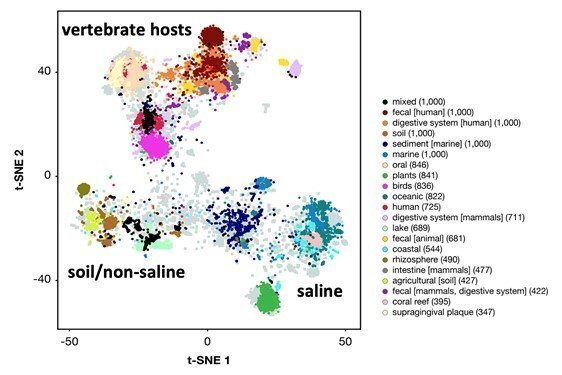
- Life
Published: | By: Ute Schönfelder
Source article
Prof. Dr. Bas E. Dutilh is an expert in modelling microbial balances.
Image: Jens Meyer (University of Jena)What defines the habitat – the ecological niche – of a microorganism? It is a combination of environmental factors such as temperature, moisture, and nutrient content. But the exact contribution of each of these factors is difficult to predict. A German-Dutch research team has redefined microbial niches by determining which microorganisms live together. Led by Prof. Dr Bas E. Dutilh from the University of Jena and Utrecht University, the researchers present this "social niche breadth" approach in the current issue of the journal "Nature Ecology and Evolution" and use it to chart the first "Map of the Microverse".
Whether in hot springs, in the human intestine or in the deep sea – microorganisms colonise almost every place on earth, sometimes under extreme conditions. Depending on how these organisms have adapted to the particular environmental conditions in such ecological niches, ecologists classify them as "generalists" or "specialists". While generalists can cope with a wide range of environmental conditions, specialists grow only under very specific circumstances.
"A key question for the study of such different microbial strategies is how to define microbial ecological niches in the first place," says Prof. Dr Bas E. Dutilh. Until now, this has mainly been done based on subjective environmental parameters, which hardly allow unbiased quantification of the niche. The bioinformatician from the Cluster of Excellence "Balance of the Microverse"External link at the University of Jena, together with researchers from Utrecht University, has therefore used a novel – data-driven – method to describe microbial niches, in which the species community itself is considered the decisive environmental factor instead of external habitat conditions. This works because microbial communities adapt rapidly to their environment, so their composition reflects the sum of all environmental factors.
Most microbial habitats dominated by generalists
For their study, the researchers analysed and quantified thousands of metagenomic data sets from different microbial samples from all over the world. "We found that in most habitats, generalists are dominant," says Dutilh. The researchers were initially surprised by this finding, as they had assumed that in local niches, specialists might prevail because they are better adapted to the particular conditions. But they found that competing generalists could grow much faster and thus gain dominance in the niche. “For the generalists it’s hit-or-miss, though; either they make it or they don’t. This makes them quite variable in their presence. Specialists are more stable in their niche, albeit at low abundance.”
And there was another result that the researchers had not expected: The genomes of the generalists are not particularly large. "This was previously assumed because metabolic flexibility was thought to generally require a larger genome," reports Dutilh. But as it turns out, the correlation between niche range and genome size is more complex. "We discovered two contrasting evolutionary strategies: In habitats with relatively low local biodiversity, such as animal-associated microbiomes, the specialists have a relatively small genome. In highly biodiverse habitats such as soils, the genome of the specialists is significantly larger."
The genomes of generalists are more variable than those of specialists, with genes coming and going during evolution. This allows them to integrate genetic information from other organisms through horizontal gene transfer and thus to adapt rapidly to the local niche. “We also see specific functions that are associated with horizontal gene transfer in generalists’ genomes,” according to Dutilh. The functions associated with specialists are much more diverse, often related to very specific metabolic processes. The genomes of specialists are evolutionarily stable, unlike those of generalists.
"In conclusion, our analysis sheds new and unexpected light on microbial niche range strategies throughout the microbial tree of life," Bas E. Dutilh is convinced.
This figure shows the first “Map of the Microverse” generated by t-SNE (t-distributed Stochastic Neighbor Embedding), a dimensionality reduction algorithm that is used to display complex data on the two dimensions of a sheet of paper. The map consists of 22.5 thousand microbial datasets from 140 different types of environments, which are indicated with different colours (only the top 20 environments are coloured, the rest are grey). The figure shows how diverse these environments can be. The researchers identified generalist and specialist bacteria by analysing their distribution across these 22.5 thousand datasets.
Illustration: Bas E. DutilhOriginal publication:
F. A. B. von Meijenfeldt, P. Hogeweg, B. E. Dutilh: A social niche breadth score reveals niche range strategies of generalists and specialists, Nature Ecology and Evolution (2023), https://www.nature.com/articles/s41559-023-02027-7External link

